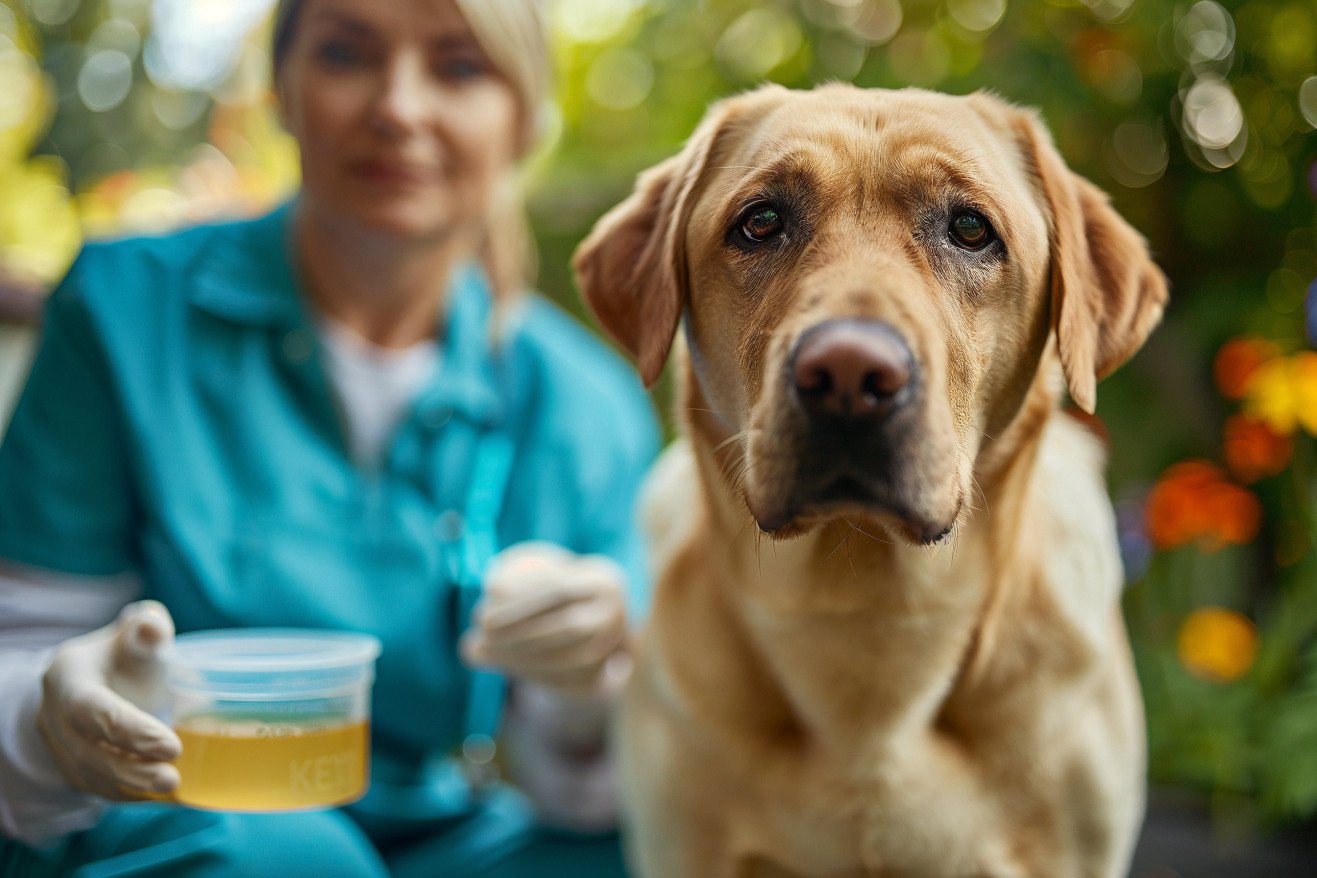How to Collect a Urine Sample From Your Dog: A Comprehensive Guide
8 May 2024 • Updated 8 May 2024

While it may seem difficult, especially if you have a larger dog, there are a few ways to get a clean urine sample from your dog. To collect a urine sample from your dog, you will need a clean container and some treats. Look for your dog's "pee stance" or take them for a walk and give them treats immediately after they go to the bathroom on a slab or puppy pad. Then, make sure to collect the sample before it's contaminated.
Below, we'll go through advice from veterinarians to help you figure out the best way to collect a clean urine sample from your dog. Knowing the right way to do this will help you get the most accurate test results, which will help you and your vet diagnose and treat any health problems your dog may be experiencing. We'll also provide step-by-step instructions for both male and female dogs, so you can be sure you know exactly what to do whether you're collecting a sample at home or at the vet's office.
How can I collect a urine sample from my dog?
How to Collect a Dog Urine Sample at Home
The free-catch method is the most popular and accessible way to collect a urine sample from your dog at home. It involves catching the urine mid-stream as your dog voluntarily urinates into a clean, shallow container such as a pie plate or ladle. The American Kennel Club recommends collecting the sample first thing in the morning when the urine is most concentrated.
To successfully collect a free-catch sample, walk your dog on a leash and watch for their "pee stance." When you see it, act fast to get the container in place to catch the urine before it hits the ground. Using a ladle or yard stick can help you catch the urine from a distance if your dog gets anxious. It can also be helpful to have a partner there to help - one person can hold the leash while the other person collects the sample.
Other at-home options include using a pee pad or a litter box to collect the urine. You can then use a syringe or pipette to extract the fresh urine, as recommended by PreventiveVet, which suggests using a clean 6 or 12mL syringe without a needle.
Regardless of the method you use, make sure you handle the sample properly. Transfer the sample to a clean, lidded container as soon as you collect it. If you won't be able to get the sample to the vet right away, store it in the refrigerator to ensure it stays fresh for accurate testing, according to the Lomsnes Veterinary Hospital. With a little bit of planning and attention to detail, most pet owners can successfully collect a usable urine sample at home. However, there are some common pitfalls to be aware of, which we'll discuss next.
How to Overcome Common Challenges
There are several challenges to collecting a urine sample from a dog, especially if the dog is shy or anxious. According to Walkerville Vet, small dogs and females are particularly likely to be startled by the collection container being placed near them, causing them to stop urinating.
To help reduce stress, Oakland Veterinary Referral Services suggests using positive reinforcement, such as treats and praise, and gradually acclimating the dog to the collection container. Having a second person hold the dog's leash can also help you concentrate on collecting the urine.
It's important to be patient. As Walkerville Vet explains, it can take up to 24 hours or even a few weeks for some anxious dogs to calm down enough to successfully collect a urine sample. Close observation and frequent bathroom breaks can help increase the likelihood of success.
If you're unable to collect a sample that's large enough or free from contaminants at home, Vets4Pets recommends asking your vet for help. It's important to stay calm and avoid punishing the dog, as this can make the process even more challenging and stressful for both the pet and the pet owner.
How Vets Collect Dog Urine Samples
Vets use a few different methods to collect a urine sample from a dog. According to VCA Animal Hospitals, the three primary collection methods are cystocentesis, catheterization, and mid-stream free flow.
Cystocentesis is the most invasive method and involves using a sterile needle and syringe to collect urine directly from the bladder. This method ensures the least contaminated sample but is more invasive. Catheterization is less invasive and involves passing a sterile catheter up the urethra into the bladder to withdraw the urine, but it has a higher risk of introducing bacteria. The mid-stream free flow method has the dog urinate voluntarily, and the sample is collected mid-stream. This method is the least invasive but has the highest risk of contamination.
Amherst Small Animal Hospital says that cystocentesis is generally the best method because it provides the least contaminated sample. The procedure involves inserting a needle through the skin and into the bladder to extract the urine. Sedation or anesthesia may be needed, especially in anxious or aggressive dogs, according to Today's Veterinary Practice.
Vets may collect the sample if owners are unable to do so at home, or if a very sterile sample is needed for certain diagnostic tests. It's important to ensure that the sample is as clean and uncontaminated as possible to ensure accurate urinalysis results, which can be an important diagnostic tool for a dog's health.
What the Urinalysis Tests For and What It Can Indicate
The urinalysis tests for a number of different things in a dog's urine, all of which can help determine the dog's overall health. According to Vet Focus, some of the most important things that are tested for include the urine's color, specific gravity, pH, and the presence of substances such as protein, glucose, or blood.
Many of the things that can be found in a urinalysis can be indicative of other health problems. For example, New Hope vets explains that the presence of red blood cells, white blood cells, crystals, bacteria, or tissue cells can be indicative of a number of health issues including bladder stones, infection, coagulation problems, trauma, or even cancer.
As Westport Vets explains, high protein levels can be indicative of kidney issues, while the presence of blood can be indicative of a bladder infection or stones. It's important to remember that the results of a urinalysis should always be considered in the context of the dog's overall clinical signs and in combination with other diagnostic tests.
According to Vet Focus, an alkaline pH, hemoglobinuria, pyuria, and the use of certain disinfectants can all cause false positives. As a result, further veterinary assessment may be needed to determine the cause of any abnormalities that are found in a urinalysis.
When to Get a Dog Urine Test From Your Vet
According to the Animal Medical Center of Chicago, some common symptoms that may warrant a veterinary urinalysis include increased thirst or urination, straining to urinate, and blood in the urine. Tracy Vets also recommends regular urinalysis for senior dogs and dogs with pre-existing conditions that may impact the urinary system.
In addition, a vet may request a urine sample during a regular checkup or if they suspect a health issue, even if your dog isn’t showing any symptoms. According to Pet Health Network, a vet may also need to collect the sample if you’re having trouble doing so at home or if a sterile sample is needed for certain tests.
It’s important to see a vet right away if you notice any symptoms or abnormalities, as early detection and treatment can often lead to better outcomes. By staying on top of your dog’s health, you can make sure they get the care they need to stay healthy.
Conclusion: Why Proper Urine Sample Collection Matters
Getting a clean, uncontaminated urine sample from your dog is essential for accurate diagnostic testing. This article has covered a wide range of methods for collecting a urine sample, from those you can do at home to those that require a vet's assistance.
Whether you're using the free-catch method or one of the alternative home methods, the most important thing to remember is to be patient and persistent. Vets can use more invasive methods like cystocentesis or catheterization to get a sterile sample when necessary. Understanding the results of a urinalysis can help you learn more about your dog's health, including everything from potential urinary tract infections to kidney disease.
If you see any symptoms or results that are concerning, it's important to get your dog to the vet as soon as possible. It's also a good idea to make sure that regular urinalysis testing is part of your dog's overall wellness plan, especially as they get older. By making sure that you're using the right methods and working with your vet, you can make sure that your dog stays healthy and happy.


